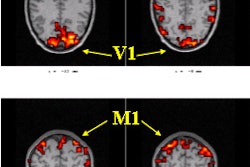GE Medical Systems yesterday unveiled Excite, a new MR technology it says will improve the speed, image quality, and processing abilities of its Infinity MR scanner. GE introduced the technology at the 2002 International Society for Magnetic Resonance in Medicine (ISMRM) meeting, being held this week in Hawaii.
MR procedure volume will double by 2005, while image data volume is expected to triple. As a result, MR scanners need a more efficient data "pipeline" to be able to accommodate this environment, said David Weber, manager of GE's global high-field MR business.
Excite targets image transmission, reception, and processing, according to the Waukesha, WI-based vendor. For image transmission, GE has incorporated new microprocessor technology to control switching of the gradients and radiofrequency electronics, as well as a significant increase in memory to store and play out multiple pulse sequences, he said.
"We're going to be able to sustain echoplanar imaging rates of up to about 35 frames per second," Weber said. "In general, our performance of pulse sequences is going to be limited only by imaging physics, without any other additional bottlenecks due to hardware or computer delays."
For image reception improvements, GE has developed a family of five eight-channel phased-array coils, including a brain coil, a neurovascular coil, a cardiac coil, a torso coil, and a spine coil. Additional coils are in development, Weber said. The new coils will be coupled with a set of receiver channels currently configured at 16 quadrature receiver channels, each operating at about a megahertz bandwidth per channel.
"There's (also) space in the system to accommodate expanding these channels up to 64 quadrature channels," Weber said.
In processing enhancements, GE has increased the memory available for reconstruction by 400%, to two gigabytes, Weber said. Image reconstruction rates have been doubled to 400 Fourier transforms per second.
The technology will improve data throughput and efficiency by more than 400% overall, Weber said. Of clinical import, GE said that Excite's new coils generate a 40% higher signal-to-noise ratio, allowing for higher-quality images, support for applications and protocols such as isotropic 3-D imaging, or for reductions in imaging time.
Excite also brings added reconstruction power to manage large data sets in a clinically efficient time, Weber said. Gains in acquisition speed have also allowed for development of new MRI protocols, he said.
"We've now demonstrated abdominal imaging while the patient is freely breathing," he said. "So we are beginning to see development of protocols that may ultimately eliminate the need for a patient to undergo multiple breath-holds during an exam."
Excite also provides for 4-D image acquisitions, producing dynamic 3-D images, Weber said. "We're able to capture the lungs breathing, the blood flowing, or the heart beating," he said.
Excite will be available on new and previously installed Infinity 1.5-tesla scanners as part of GE’s Continuum upgrade program, GE said. The vendor estimates that the Excite technology will add 10% to 20% to the cost of an MR scanner.
GE has installed Excite at Evanston Northwestern Healthcare in Evanston, IL, Edison Imaging in Edison, NJ, and South Jersey Radiological Associates in New Jersey. The vendor plans to install 250 more Excite systems by the end of 2002, and 1,000 units within two years. GE said it spent more than three years and $31 million developing Excite.
By Erik L. RidleyAuntMinnie.com staff writer
May 21, 2002
Related Reading
Signa Infinity MRI cleared by FDA, February 12, 2002
Safety concerns and clinical advances highlight year in MRI, November 14, 2001
Copyright © 2002 AuntMinnie.com




.fFmgij6Hin.png?auto=compress%2Cformat&fit=crop&h=100&q=70&w=100)




.fFmgij6Hin.png?auto=compress%2Cformat&fit=crop&h=167&q=70&w=250)











